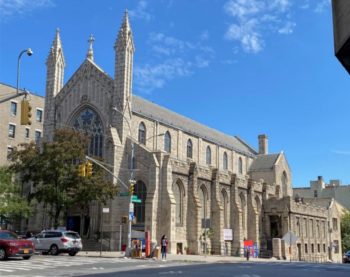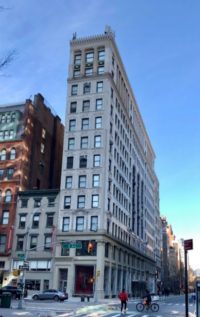
Holyrood Episcopal Church-Iglesia Santa Cruz, one of the three sites calendared by LPC on January 19th. Image Credit: LPC
Support for landmarking included a push for further preservation of the area south of Union Square. On March 23, 2021, the Landmarks Preservation Commission held public hearings on two proposed landmarks located in Manhattan. The Holyrood Episcopal Church-Iglesia Santa Cruz at 715 West 179th Street in Washington Heights and the Educational Building at 70 Fifth Avenue in Greenwich Village were two landmarks originally calendared as part of the Landmarks Preservation Commission’s new Equity Framework. The Equity Framework highlights the agency’s efforts for landmark designations that represent the city’s diverse and inclusive history. For CityLand’s prior coverage of the Equity Framework and calendaring, click here.
Holyrood Episcopal Church-Iglesia Santa Cruz
The Holyrood Episcopal Church-Iglesia Santa Cruz is a Gothic Revival church completed in 1916. The church is both architecturally and culturally significant. Some of the church’s features include a large stained front glass window flanked by stepped buttresses with a tall pinnacle on each side and a rough faced stone facade with terra cotta details. Culturally, the church’s growth has reflected that of the Washington Heights neighborhood it resides in; the church’s congregation shifts followed the changing demographics of the neighborhood. The Holyrood Episcopal Church has historically been more progressive, and today offers programs for the hearing impaired, contains space for the Dominican Women’s Development Center, and serves as a sanctuary church for undocumented people.
Several people spoke in support of designating the church. First, Father Luis Barrios, the Priest in Charge of Holyrood, spoke about the church’s role in the community, including serving as a sanctuary church and offering support for the homeless and the LGBTQ community. Father Barrios also discussed how the church has opened its door more during the duration of the COVID-19 pandemic to help support the community. Andrea Goldwyn of the New York Landmarks Conservancy spoke in support of the designation and highlighted architectural features of the church. Diego Robayo of the Historic Districts Council testified about the shifts in immigration and demographic changes across Washington Heights and how the church has served those populations.
The Educational Building
The Educational Building is an L-shaped Beaux Arts style office building completed in 1914 for book publisher George Arthur Plimpton. The building, located in Greenwich Village, served as the national office of the NAACP from 1914 to 1923 and was home to other notable social reform and non-profit tenants including but not limited to the National Civil Liberties Bureau (later to become the American Civil Liberties Union), the New York Teachers Union, the National Child Welfare Association, and the Women’s Peace Party. The building is currently owned by the New School for Social Research and is currently a part of the Sheila C. Johnson Design Center at the Parsons School of Design/The New School.

70 Fifth Avenue, the Educational Building. Image Credit: LPC
There were many speakers in support of designating the Educational Building. Jo Goldberger, the Assistant Vice President of Design and Construction at the New School testified that the school is proud to call the Educational Building home, and that they take responsibility for the care for the building and support the designation. A representative for Assembly Member Deborah Glick testified that the purpose of landmarking is to preserve the historic nature and sense of place in a neighborhood, and that is what the Educational Building does. Andrea Goldwyn of the New York Landmarks Conservancy also testified in this hearing in support, citing the architectural significance of the building with its detailed facade.
Several speakers in support emphasized the importance of preserving the Educational Building and its surrounding neighborhood. Conor Allerton, an urban planner for Manhattan Borough President Gale Brewer discussed how landmarking the Educational Building was an important step in preserving the area below Union Square.
Andrew Berman, Executive Director of the Greenwich Village Society for Historic Preservation, testified in support of designation but also discussed the Society’s campaign for a proposed historic district for the area south of Union Square between Third and Fifth Avenues from 14th to 9th Streets, which would include the Educational Building. The campaign advocates for a proposed historic district to preserve buildings at risk of being lost during the expansion of the tech industry in the area, and includes comprehensive research about how the area impacted civil rights movements, the labor movements, and the arts and literature.
Simeon Bankoff, Executive Director of the Historic Districts Council, testified about the historical significance of the Educational Building’s tenants and the area as a whole. He agreed that the area south of Union Square would be better off preserved as a larger district than by individual landmarks, like the designation of the nearby seven Broadway buildings which were landmarked in 2019. During that designation process, advocates called for a larger preservation effort of the area over the piecemeal approach of designating individual buildings within the area.
According to Landmarks staff, the Commission received over 80 letters in support of designation of the Educational Building.
There were no speakers in opposition for either proposed landmark.
Landmarks will hold a vote to designate both proposed landmarks at a future date.
By: Veronica Rose (Veronica is the CityLaw fellow and a New York Law School graduate, Class of 2018.)

